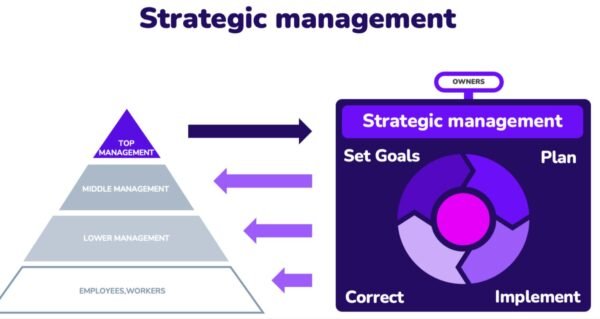
Strategic management is the comprehensive procedure that involves formulating, implementing and evaluating strategies in order to reach objectives of the organization. It allows businesses to stay in the game and adjust to changing marketplaces. Although strategic management has many advantages, it also comes with its own challenges. This article outlines the benefits and disadvantages of strategic planning in greater detail.
What is Strategic Management?
Strategic management is the process of setting out an organization’s mission goals, and vision and subsequently establishing strategies to meet these goals. It includes constant planning, monitoring, and evaluation to ensure an alignment with the organization’s objectives and the ever-changing market. Strategic management can be applied to different sectors, such as corporations, firms, government entities as well as non-profit organizations.
Advantages of Strategic Management
- Clear Direction
Strategic management can provide an unambiguous sense of purpose and direction, which ensures that employees are in alignment to the company’s objectives. - Improved Organizational Performance
Businesses with well-defined strategies perform better since resources are effectively allocated and resources are focusing on tasks that are high-priority. - Enhanced Decision-Making
Strategic management assists leaders in making well-informed decisions based on a comprehensive analysis of their the external and internal environments. - Adaptability to Change
The method allows companies to anticipate and react to shifts in market technology, the customer, and their preferences, which ensures long-term sustainability. - Competitive Advantage
By identifying risks and opportunities by identifying opportunities and threats, strategic management helps firms to maximize their strengths and minimize their weaknesses, thereby gaining an edge. - Efficient Resource Allocation
It assures that resources like time as well as money and personnel are effectively used to meet organizational goals. - Increased Employee Engagement
If employees are aware of the company’s goals and the role they play in getting them there, they’re more enthusiastic and committed. - Risk Management
Strategic management involves the assessment of risks and mitigation strategies to reduce the potential impact of challenges. - Long-Term Focus
In contrast to day-to-day operations and routine Strategic management focuses on the long-term, which means making sure that sustainable growth and development are achieved.
Disadvantages of Strategic Management
- Time-Consuming
Strategic planning and implementation and evaluation takes a lot of effort and time that can delay the immediate action. - High Costs
Strategic management typically requires hiring experts, carrying out exhaustive research, and employing advanced tools. This can be expensive for small firms. - Complexity
The process is often complex especially for large corporations that have multiple markets and operations which require coordination and expertise. - Resistance to Change
Management and employees may be resistant to changes made by strategic management, resulting in delays or even conflicts. - Uncertainty in Results
Even with meticulous strategy, strategies may not deliver the results you expect due to unpredictability of external forces like market volatility or technological disruptions. - Risk of Over-Planning
Too much focus on analysis and planning could cause organizations to delay action, and to overlook opportunities. - Dependence on Leadership
Success of strategic planning depends upon the visionary abilities of the top executives. A lack of leadership could undermine the whole process. - Challenges in Implementation
Even well-crafted strategies could be unsuccessful if they are not properly implemented typically due to a insufficient resources, lack of communication, or even employee participation. - Potential for Tunnel Vision
The focus on long-term goals can result in a lack of attention to immediate operational issues that can impact the performance of short-term goals.
Comparison Table: Advantages vs. Disadvantages
| Advantages | Disadvantages |
|---|---|
| Provides clear direction | It is a time-consuming process |
| Improves the performance of organizations | Costs for implementation that are prohibitive |
| Improves decision-making | Complexity in large companies |
| It allows for flexibility to adapt to change | The resistance of employees to change |
| Gain competitive advantage | Uncertainty in achieving desired outcomes |
| Ensures efficient resource allocation | Risk of over-planning and delaying actions |
| Employee engagement is increased | A lot depends on leadership qualities |
| Mitigates risks | The challenges of implementation |
| It focuses on growth that will last for a long time | The potential for ignoring short-term concerns |
Applications of Strategic Management
The term “strategic management” is used extensively in:
- Corporation Sector For identifying market trend, improve operations, and grow market share.
- Government Sector to formulate policy in resource allocation and achieving social objectives.
- Non-Profits In order to match mission-driven goals and financial viability.
- Small Business: For efficient resource utilization and positioning in the market.
Key Steps in Strategic Management
- Analyse of the Environment: Assess internal strengths and weaknesses, as well as external threats and opportunities (SWOT assessment).
- Strategies Formulation Design strategies which are in line with the goals of the organization along with market and economic conditions.
- Application: Apply the method by ensuring efficient communications and allocation of resources.
- Assessment: Continuously monitor performance and make any necessary adjustments.
How to Overcome Challenges
- Streamline Procedures Utilize tools and technology to facilitate the process of strategic preparation and implementation.
- Promote communication: Ensure all stakeholders know and accept the plan.
- Train employees and leaders: Provide training to increase skills and reduce resistance to change.
- Monitor and adjust: Regularly review strategies to adjust to changes in the environment.
Conclusion
Strategic management is an effective instrument for companies that are looking to reach their goals over the long term. The benefits it offers, such as enhanced performance, adaptability and competitive edge makes it an essential part of modern business procedures. However the cost, time and complexity can be challenging, particularly for smaller companies.
To reap the maximum benefits from strategic planning, companies must focus on efficient plan, efficient implementation and continual assessment. By addressing the weaknesses of strategic management organizations can develop an effective framework for expansion, resilience and achievement in today’s fast-paced world.
